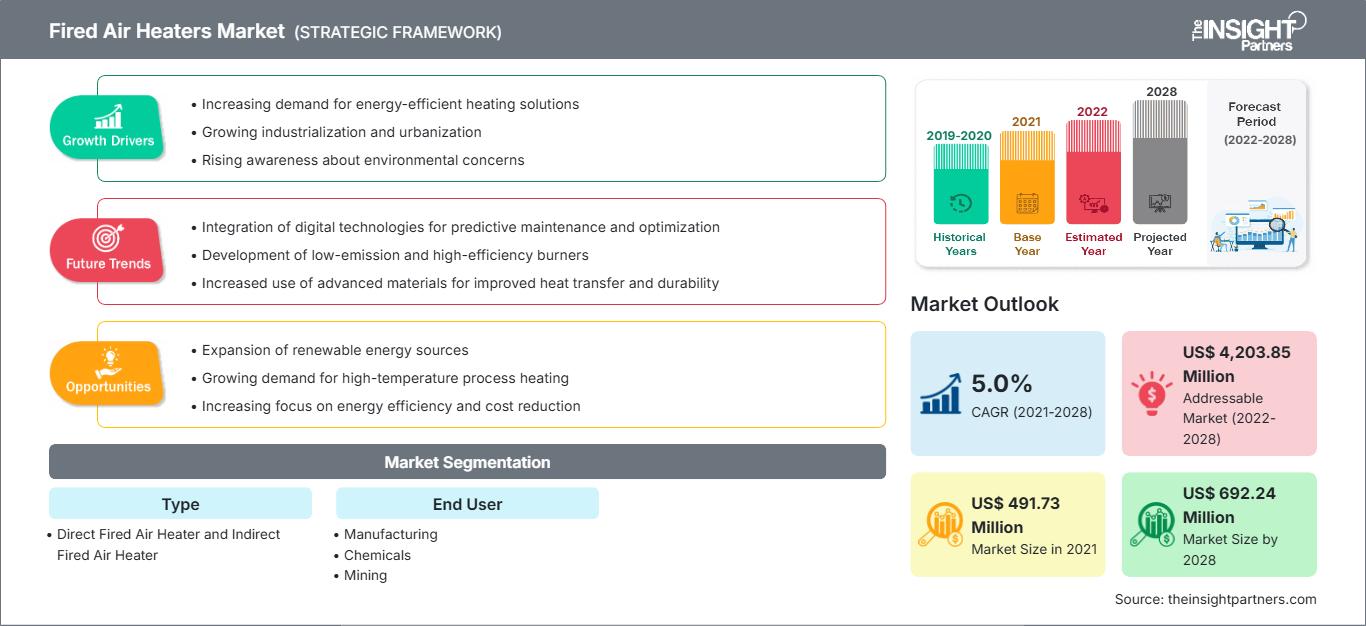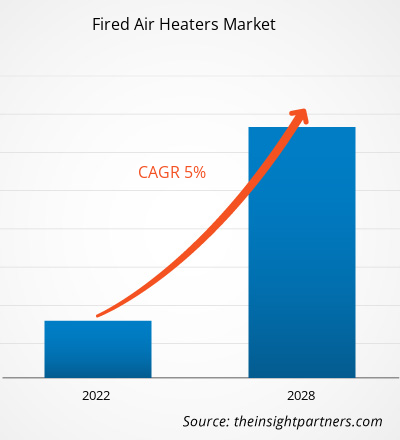Si prevede che il mercato dei generatori d'aria calda a combustione crescerà da 491,73 milioni di dollari nel 2021 a 692,24 milioni di dollari entro il 2028; si stima una crescita a un CAGR del 5,0% dal 2021 al 2028.
L'aumento della domanda di apparecchiature di riscaldamento per applicazioni industriali nei paesi emergenti è un importante motore per il mercato dei generatori d'aria calda a combustione. La domanda di generatori d'aria calda a combustione è trainata dalla crescente domanda di energia da parte di aziende in economie emergenti come Cina, India, Giappone e Brasile. Inoltre, grazie ai tempi di avviamento rapidi, all'elevata efficienza e all'affidabilità, la domanda di generatori d'aria calda a combustione nei settori manifatturiero, della produzione di energia e della trasformazione è aumentata. Anche i maggiori investimenti nella capacità di generazione di energia sono un altro fattore trainante per i generatori d'aria calda a combustione. Grazie a decenni di sviluppi nella tecnologia di produzione, la domanda di generatori d'aria calda a combustione continua a crescere in modo significativo.
I generatori d'aria calda a combustione sono comunemente utilizzati nell'industria di trasformazione per riscaldare gas o liquidi a una temperatura specifica. Inoltre, l'integrazione dell'Internet delle cose (IoT) nei generatori d'aria calda a combustione ne aumenterebbe l'adozione, alimentando la crescita del mercato durante il periodo di previsione.
Personalizza questo rapporto in base alle tue esigenze
Potrai personalizzare gratuitamente qualsiasi rapporto, comprese parti di questo rapporto, o analisi a livello di paese, pacchetto dati Excel, oltre a usufruire di grandi offerte e sconti per start-up e università
Mercato dei riscaldatori d'aria calda: Approfondimenti strategici

-
Ottieni le principali tendenze chiave del mercato di questo rapporto.Questo campione GRATUITO includerà l'analisi dei dati, che vanno dalle tendenze di mercato alle stime e alle previsioni.
Impatto della pandemia di COVID-19 sul mercato dei riscaldatori d'aria a combustione
La pandemia di COVID-19 ha avuto un impatto significativo sul mondo e continua a devastare diversi paesi. Fino allo scoppio del COVID-19, il settore dei riscaldatori d'aria a combustione stava registrando una crescita sostanziale in termini di produzione. Sfortunatamente, l'epidemia di COVID-19 ha decimato la domanda di riscaldatori d'aria a combustione in diversi settori a livello globale, riflettendo volumi di ordini significativamente inferiori tra i produttori di aeromobili, con conseguente riduzione del numero di produzioni. Il calo dei volumi di produzione ha avuto un impatto negativo sulle attività di vari produttori di componenti e sulle tecnologie associate. Inoltre, l'indebolimento di utenti finali come l'edilizia, l'industria automobilistica e l'industria mineraria ha demotivato il mercato. Pertanto, le attività degli operatori del mercato dei riscaldatori d'aria a combustione sono state gravemente colpite dalla destabilizzazione della produzione. Durante la diffusione del virus COVID-19, l'intero settore delle costruzioni si è fermato con risorse minime per prevedere il futuro. Diverse unità produttive negli Stati Uniti, in Francia, in Russia e in Cina sono state temporaneamente sospese per rispettare le norme governative in materia di lockdown e distanziamento sociale. Gli operatori del settore edile hanno registrato una riduzione del 20-30% della domanda di nuovi progetti. Inoltre, l'interruzione dei progetti di costruzione in corso ha ulteriormente indebolito il mercato. Questo fattore ha avuto un impatto negativo sul mercato dei riscaldatori d'aria calda.
Approfondimenti sul mercato dei riscaldatori d'aria calda
Aumento della domanda di apparecchiature di riscaldamento per applicazioni industriali
Caldaie, pompe di calore e forni sono apparecchiature di riscaldamento industriale utilizzate nei settori chimico, alimentare, edile, minerario e in altri settori per svolgere processi produttivi. Una caldaia è un recipiente chiuso in cui l'acqua o un altro liquido viene riscaldata e si forma vapore, successivamente utilizzato per azionare le macchine quando erogato ad alta pressione. Inoltre, una pompa di calore è un dispositivo che trasferisce calore ad aree calde o fredde. Infine, i forni sono componenti essenziali di un sistema di riscaldamento centralizzato. Nei ribollitori di ammine e glicole, i gas corrosivi di idrogeno solforato e anidride carbonica devono essere rimossi dal vapore di idrocarburi prima che i rispettivi combustibili possano essere stoccati o introdotti nella conduttura per la raffinazione del gas naturale e del petrolio greggio. Analogamente al vapore di gas naturale, il glicole viene utilizzato per rimuovere l'acqua dal gas naturale prima della distribuzione. Grazie alla sua manutenzione economica e alla semplicità, questo tipo di riscaldatore viene utilizzato nei settori del gas naturale, del petrolio greggio e della lavorazione. Nel settore dei processi chimici, i riscaldatori a combustione sono comunemente utilizzati per riscaldare i fluidi di processo e generare vapore. Nella maggior parte dei casi, i riscaldatori a combustione consumano la maggior parte dell'energia nell'industria di processo. Un riscaldatore a scatola con tubi verticali viene utilizzato per riscaldare un fluido idrocarburico per questa indagine. I riscaldatori a eluizione, un'applicazione specializzata dei riscaldatori d'aria a combustione che richiede un design distinto e unico, sono utilizzati nell'industria mineraria. L'eluizione è il processo di estrazione di un materiale da un altro mediante lavaggio con un solvente, quasi sempre con l'aggiunta di calore, nella chimica analitica e organica. Minerali come l'oro vengono estratti utilizzando scambiatori. Una soluzione minerale e solvente circola da un lato dello scambiatore, mentre un fluido termovettore, comunemente un fluido termico, si distribuisce dall'altro. Nell'industria alimentare, in particolare nei treni di frittura – patate, snack e prodotti precotti – il riscaldamento avviene tramite riscaldatori a fluido termovettore, in cui circola un fluido termico che viene riscaldato nell'apparecchiatura e il cui calore viene trasferito all'olio che frigge i prodotti sovrastanti attraverso uno scambiatore. In questo ambito sono state realizzate alcune installazioni, simili al processo di eluizione mineraria, in cui l'olio di frittura circola direttamente attraverso la caldaia, che viene successivamente utilizzata come riscaldatore d'aria. I riscaldatori a fuoco diretto vengono occasionalmente utilizzati come riscaldatori a fluido termovettore o come riscaldatori indiretti nell'industria petrolchimica. Il buon funzionamento del servizio di manutenzione dei riscaldatori a fuoco diretto negli impianti chimici e nelle raffinerie e l'uniformità dei pezzi di ricambio sono le ragioni principali di questa diffusione, poiché i riscaldatori a fluido termovettore sono rinomati per i loro vantaggi nelle loro funzioni specifiche. Pertanto, l'aumento della domanda di apparecchiature di riscaldamento per varie applicazioni industriali sta trainando il mercato dei generatori d'aria calda a combustione.
Approfondimenti di mercato basati sulla tipologia
In base alla tipologia, il mercato dei generatori d'aria calda a combustione è stato segmentato in generatori d'aria calda a combustione diretta e generatori d'aria calda a combustione indiretta. I generatori d'aria calda a combustione diretta offrono un mezzo sicuro per riscaldare gli ambienti industriali mantenendo un rapporto aria/combustibile adeguato, gas naturale o propano. Il gas viene erogato direttamente al bruciatore in un generatore d'aria calda a combustione diretta, mentre il flusso d'aria fornisce l'ossigeno necessario per la combustione. Il gas viene miscelato con l'aria che viene convogliata attraverso il deflettore del bruciatore. Il bruciatore è configurato per bruciare in tandem e parallelamente al flusso d'aria. Il consumo di carburante e le spese di gestione sono ridotti poiché circa il 100% del carburante viene convertito in calore.
Mercato dei riscaldatori d'aria calda
Le tendenze regionali e i fattori che influenzano il mercato dei riscaldatori d'aria calda durante il periodo di previsione sono stati ampiamente spiegati dagli analisti di The Insight Partners. Questa sezione illustra anche i segmenti e la geografia del mercato dei riscaldatori d'aria calda in Nord America, Europa, Asia-Pacifico, Medio Oriente e Africa, America Meridionale e Centrale.
Ambito del rapporto di mercato sui riscaldatori d'aria calda
| Attributo del rapporto | Dettagli |
|---|---|
| Dimensioni del mercato in 2021 | US$ 491.73 Million |
| Dimensioni del mercato per 2028 | US$ 692.24 Million |
| CAGR globale (2021 - 2028) | 5.0% |
| Dati storici | 2019-2020 |
| Periodo di previsione | 2022-2028 |
| Segmenti coperti |
By Tipo
|
| Regioni e paesi coperti |
Nord America
|
| Leader di mercato e profili aziendali chiave |
|
Densità degli operatori del mercato dei riscaldatori d'aria calda: comprendere il suo impatto sulle dinamiche aziendali
Il mercato dei riscaldatori d'aria calda a combustione è in rapida crescita, trainato dalla crescente domanda degli utenti finali, dovuta a fattori quali l'evoluzione delle preferenze dei consumatori, i progressi tecnologici e una maggiore consapevolezza dei vantaggi del prodotto. Con l'aumento della domanda, le aziende stanno ampliando la propria offerta, innovando per soddisfare le esigenze dei consumatori e sfruttando le tendenze emergenti, alimentando ulteriormente la crescita del mercato.

- Ottieni il Mercato dei riscaldatori d'aria calda Panoramica dei principali attori chiave
Gli operatori che operano nel mercato dei riscaldatori d'aria calda a combustione adottano strategie come fusioni, acquisizioni e iniziative di mercato per mantenere le proprie posizioni. Di seguito sono elencati alcuni sviluppi dei principali operatori:
- Nel 2018, Allmand Bros. Inc., produttore ottantenne di attrezzature da cantiere portatili ad alte prestazioni e sussidiaria di Briggs & Stratton Corporation, ha ampliato il suo attuale stabilimento di Holdrege, Nebraska, per aumentare la capacità produttiva e la velocità di commercializzazione con nuove tecnologie.
- Nel 2018, Pirobloc, leader nella progettazione e produzione di riscaldatori a olio diatermico, ha aperto una filiale negli Stati Uniti. Pirobloc USA è già una realtà ed è pienamente operativa.
Il mercato globale dei riscaldatori d'aria calda a combustione è stato segmentato come segue:
Mercato dei riscaldatori d'aria calda a combustione: per tipo
- Riscaldatori d'aria a combustione diretta
- Riscaldatori d'aria a combustione indiretta
Mercato dei riscaldatori d'aria a combustione - per utente finale
- Produzione
- Prodotti chimici
- Estrazione mineraria
- Magazzini
- Petrolio e gas
- Prodotti farmaceutici
- Altri
Mercato dei riscaldatori d'aria a combustione - per area geografica
- Nord America
- Stati Uniti
- Canada
- Messico
- Europa
- Germania
- Francia
- Italia
- Regno Unito
- Russia
- Resto d'Europa
- Asia Pacifico (APAC)
- Australia
- Cina
- India
- Giappone
- Corea del Sud
- Resto dell'APAC
- Medio Oriente e Corea del Sud. Africa (MEA)
- Sudafrica
- Arabia Saudita
- Emirati Arabi Uniti
- Resto del MEA
- Sud America (SAM)
- Brasile
- Argentina
- Resto del SAM
Profili aziendali
- ALLMAND BROS., INC
- Exotherm Corporation
- Hastings HVAC, Inc.
- Pirobloc, SA
- SIGMA THERMAL, INC
- Stelter & Brinck, Ltd.
- Tamarack Industries
- Therm Dynamics
- Wacker Neuson SE
- Zeeco, Inc
- Analisi storica (2 anni), anno base, previsione (7 anni) con CAGR
- Analisi PEST e SWOT
- Valore/volume delle dimensioni del mercato - Globale, Regionale, Nazionale
- Industria e panorama competitivo
- Set di dati Excel
Report recenti
Rapporti correlati
Testimonianze
Motivo dell'acquisto
- Processo decisionale informato
- Comprensione delle dinamiche di mercato
- Analisi competitiva
- Analisi dei clienti
- Previsioni di mercato
- Mitigazione del rischio
- Pianificazione strategica
- Giustificazione degli investimenti
- Identificazione dei mercati emergenti
- Miglioramento delle strategie di marketing
- Aumento dell'efficienza operativa
- Allineamento alle tendenze normative






















 Ottieni un campione gratuito per - Mercato dei riscaldatori d'aria calda
Ottieni un campione gratuito per - Mercato dei riscaldatori d'aria calda